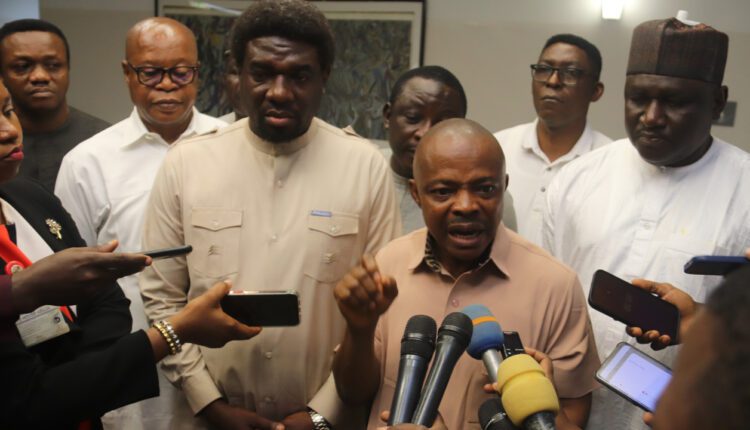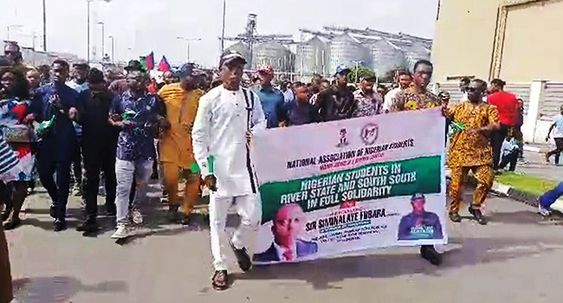Headlines
NLC, TUC Hold Firm on Indefinite Strike Despite Talks with NASS, SGF

The Nigeria Labour Congress (NLC) and Trade Union Congress (TUC) have reiterated their dedication to moving forward with the scheduled indefinite strike regarding the new minimum wage.
Despite last-minute efforts from the National Assembly leadership to prevent possible economic disturbances, the organized labour insists that the strike will start on Monday.
Both unions have stated that, although they appreciate the plea from the National Assembly leadership to review the planned strike, they will meet to discuss the issue.
The determination to proceed with the strike stands firm as they aim to engage in additional discussions with their respective bodies before making a final decision.
The Nigerian Labour Congress (NLC) and the Trade Union Congress (TUC) have announced their decision to continue with an indefinite strike despite recent negotiations with the National Assembly (NASS) and the Secretary to the Government of the Federation (SGF). This decision underscores the unions’ dissatisfaction with the government’s responses to their demands and highlights the ongoing tensions in Nigeria’s labor landscape.
Background
Role and Significance of NLC and TUC in Nigeria
The NLC and TUC are the primary labor unions in Nigeria, representing millions of workers across various sectors. These unions play a critical role in advocating for workers’ rights, fair wages, and better working conditions. Historically, they have been instrumental in driving significant labor reforms and influencing government policies.
Historical Context of Labor Strikes in Nigeria
Labor strikes have been a common feature in Nigeria’s socio-political landscape. Over the years, the country has witnessed numerous strikes, often driven by demands for improved wages, better working conditions, and opposition to unpopular government policies. These strikes have had varying degrees of success and impact.
Reasons for the Strike
Key Demands of the NLC and TUC
The current strike is driven by several key demands from the NLC and TUC, including:
- Implementation of the new national minimum wage
- Improved funding for public education and healthcare
- Enhanced worker protections and job security
- Measures to address the rising cost of living
Issues Prompting the Strike Action
The unions have cited the government’s failure to fully address these demands as the primary reason for the strike. Despite previous negotiations and assurances, many of the unions’ concerns remain unresolved, leading to heightened frustration among workers.
Negotiations with NASS and SGF
Summary of Discussions with NASS and SGF
Recent discussions between the unions and representatives from the National Assembly and the SGF have been intense. Key points of discussion included the feasibility of the new minimum wage, funding allocations for critical sectors, and broader economic policies affecting workers.
Points of Contention and Areas of Agreement
While some progress was made on specific issues, significant points of contention remain. The unions have expressed dissatisfaction with the pace and extent of government concessions, particularly on wage increases and job security measures.
NLC and TUC’s Position
Reasons for Rejecting Proposals from NASS and SGF
The NLC and TUC leaders have firmly rejected the proposals put forward by NASS and the SGF, arguing that they fall short of meeting the unions’ demands. They have highlighted the need for more substantial and immediate actions to address workers’ grievances.

Statements from NLC and TUC Leaders
In their public statements, union leaders have emphasized their commitment to fighting for workers’ rights and expressed a willingness to continue the strike until their demands are met. They have called for solidarity among workers and urged the government to take more decisive action.
Impact of the Strike
Immediate Effects on the Economy and Public Services
The strike has already begun to disrupt various sectors, including public transportation, healthcare, and education. The economy is experiencing slowdowns as businesses grapple with reduced productivity and increased uncertainty.
Long-Term Implications for Labor Relations in Nigeria
Prolonged strike action could have lasting effects on labor relations in Nigeria, potentially leading to more stringent labor laws, changes in union strategies, and shifts in public perception of labor movements.
Public Reaction
Response from the General Public and Various Stakeholders
Public reaction to the strike is mixed. While many sympathize with the unions’ demands, there is also concern about the broader economic impact and disruption to daily life. Various stakeholders, including business leaders and civil society organizations, have weighed in on the issue.
Media Coverage and Public Opinion
Media coverage has been extensive, with varying opinions presented. Some outlets have focused on the legitimacy of the unions’ demands, while others have highlighted the negative consequences of the strike on the economy and public services.
Government Response
Official Statements from the Government
The government has issued statements expressing its commitment to resolving the issues and minimizing the impact of the strike. Officials have called for continued dialogue and urged the unions to consider the broader implications of prolonged industrial action.
Steps Taken to Mitigate the Impact of the Strike
In response to the strike, the government has taken steps to maintain essential services and mitigate economic disruptions. These measures include contingency plans for critical sectors and continued efforts to engage with union leaders.
Comparative Analysis
Comparison with Previous Major Strikes in Nigeria
Comparing the current strike with previous major strikes in Nigeria reveals similarities in terms of demands and government responses. However, the current economic and social context presents unique challenges and opportunities for both the unions and the government.

Lessons Learned and Differences in the Current Situation
Lessons from past strikes highlight the importance of effective negotiation and the potential for long-term reforms. The current situation differs in its scale and the heightened economic pressures facing the country.
Potential Outcomes
Possible Scenarios if the Strike Continues
If the strike continues, possible scenarios include increased economic strain, further disruptions to public services, and potential concessions from the government. Alternatively, prolonged stalemate could lead to more significant social unrest and political pressure.
Impact on Future Negotiations and Labor Policies
The outcome of the current strike will likely influence future labor negotiations and policies. Successful resolution could set a precedent for more responsive and proactive government engagement with labor issues.
Strategies for Resolution
Potential Compromises and Solutions to End the Strike
Potential solutions include phased implementation of wage increases, targeted investments in critical sectors, and enhanced dialogue mechanisms. Both sides will need to demonstrate flexibility and a commitment to finding common ground.
Role of Mediation and Third-Party Intervention
Mediation and third-party intervention could play a crucial role in breaking the deadlock. Involving neutral parties to facilitate negotiations can help build trust and identify mutually acceptable solutions.
Economic Impact
Detailed Analysis of the Strike’s Economic Consequences
The strike’s economic impact includes reduced productivity, disrupted supply chains, and decreased investor confidence. Long-term consequences could affect economic growth and stability, particularly if the strike persists.
READ ALSO: NLC and TUC call for the reversal of power sector privatization in Nigeria
Sectors Most Affected by the Strike
Sectors most affected include public services (healthcare, education, transportation), manufacturing, and retail. These disruptions have ripple effects throughout the economy, affecting businesses and consumers alike.
Social Implications
Effect on Social Services and Daily Life
The strike’s impact on social services is significant, with healthcare and education facing particular challenges. Daily life for many Nigerians is disrupted, leading to increased frustration and potential social unrest.
Public Sentiment Towards the Strike
Public sentiment is divided, with some supporting the unions’ demands and others concerned about the broader consequences. Ongoing communication and engagement with the public are essential for managing perceptions and maintaining support.
Legal Perspective
Legal Rights and Constraints Regarding Labor Strikes in Nigeria
Labor strikes in Nigeria are governed by specific legal frameworks that outline the rights and responsibilities of unions and employers. Understanding these legal parameters is crucial for both the unions and the government in navigating the current situation.
Possible Legal Actions by the Government or Unions
Possible legal actions include court interventions, arbitration processes, and regulatory measures. These actions could influence the dynamics of the strike and its resolution.
Conclusion
The NLC and TUC’s decision to hold firm on their indefinite strike despite talks with NASS and the SGF highlights the deep-seated issues within Nigeria’s labor relations. The strike’s outcome will have significant implications for the country’s economic stability, labor policies, and social cohesion. As both sides continue to negotiate, finding a balanced and sustainable resolution is crucial for the future of Nigeria’s workforce and overall development.
FAQs
What are the main reasons behind the NLC and TUC strike?
The primary reasons for the strike include demands for implementing the new national minimum wage, improved funding for public education and healthcare, enhanced worker protections, and measures to address the rising cost of living.
How has the government responded to the strike?
The government has expressed a commitment to resolving the issues through continued dialogue and has implemented contingency plans to maintain essential services and mitigate economic disruptions.
What is the impact of the strike on the economy?
The strike has led to reduced productivity, disrupted supply chains, and decreased investor confidence. If prolonged, it could have long-term negative effects on economic growth and stability.
What are the potential outcomes of the ongoing strike?
Potential outcomes include increased economic strain, further disruptions to public services, potential government concessions, or prolonged stalemate leading to significant social unrest and political pressure.
How can the strike be resolved?
Resolution strategies include phased implementation of wage increases, targeted investments in critical sectors, enhanced dialogue mechanisms, and potential mediation by third parties to facilitate negotiations.
